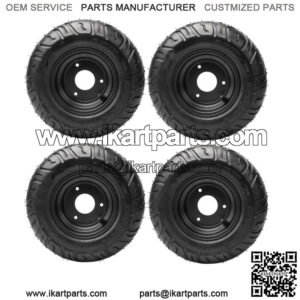It’s apparent that go-karts have small wheels, especially compared to other types of motorsport vehicles. That’s not just a coincidence! In fact, there are quite a number of reasons why that’s the case.
In this article, we’ll be taking a closer look at all of the reasons in detail on why go-kart karts have small wheels. There are also some downsides to having smaller wheels, which will be outlined towards the end of this article. Let’s jump right in!
Reasons For Smaller Wheels on Go-Karts
Racing go-karts have a unique design. They have an extremely low profile, no differentials or suspensions and are constructed as light as possible. Let’s take a closer look at the benefits of having smaller wheels.
1. Lower Center of Gravity
The smaller the wheels of a vehicle, the lower the center of gravity. This is purely because the tire and wheel diameter influence the distance between the frame of the go-kart and the track surface.
Having a low center of gravity is extremely advantageous for go-karts, as they are less prone to flip when turning force increases. This is important for taking fast corners and swift overtaking maneuvers.
2. Faster Acceleration
The winner of a race is the driver who is the fastest around the laps. To get there they will need to rely on optimal performance, especially quick acceleration. Believe it or not, smaller tires provide faster acceleration on the low-end torque range.
Technically speaking, given that the engine output and torque are generally the same, smaller wheels would turn faster than larger ones. However, this doesn’t really matter, as they also cover less ground than larger wheels. The difference actually lies in the torque ranges.
The torque of a typical racing go-kart follows a ‘concave down curve’, meaning that smaller go-kart tires reach higher RPMs faster, but drop off at the high-end torque range. Since go-kart tracks contain many corners and hairpin turns they need to excel at the lower-end torque ranges.
That’s one of the main reasons why go-karts are designed to have the smallest wheels possible, in order to maximise acceleration and reach high speeds as soon as possible.
3. Improved Handling
Smaller wheels also allow for better handling around corners. This doesn’t mean that the steering will be more comfortable. Most of the time it’s actually a little less comfortable, as smaller tires contain less air and have less dampening ability.
However, smaller wheels mean that you have the ability to change the vector of your go-kart (direction) more effectively allowing for sharper and more responsive turns.
Larger wheels would take a lot of space on your go-kart, allowing for a wider turning radius. This would also be impractical when handling hairpin turns or shaper corners. Therefore, smaller wheels would make your go-kart more agile.
4. Better Jacking Effort
As go-karts are not equipped with any differential, they rely on jacking to get around corners effectively. Jacking occurs when turning into a corner, whereby the inner rear wheel lifts, applying more force and grip on the outer tires.
Having smaller tires allows for more effective jacking. Larger tires will not easily allow this due to the added weight, as well as the increased risk of flipping over. Thanks to the lower center of gravity that smaller tires offer, jacking can be practiced safely and effectively.
5. Less Weight
Go-karts are lightweight racing machines that are built for speed and handling. The lighter the go-kart is, the faster it can accelerate and the faster it can reach its top speed. That’s also an important reason why they’re typically stripped of all non-essential components.
Larger tires usually weigh more than smaller ones. For example, larger tires that are designed for off-road go-karts can weigh two to three times as much as slick tires.
6. Less Expensive
Smaller tires are also typically less expensive, as less material is used for their construction. However, this may not be one of the main determining factors on why go-karts use smaller tires, but it’s still an advantage.
Downsides of Having Smaller Wheels
Those were the reason why racing go-karts are equipped with smaller tires. They simply offer a lot more benefits than larger ones. There are also certain downsides of racing with smaller tires; although these reasons are heavily outweighed by their advantages.
- Bumpier Ride – Smaller tires have less air and therefore a lower cushioning effect. As go-karts don’t have suspensions, this becomes noticeable relatively quickly. They partly make up for it through their flexible frames.
- Slower at High-End Torque – As smaller wheels excel at lower-end torque ranges, larger wheels perform better at the high-end torque range. In some scenarios (overtaking on straight sections) this may be noticeable, but not enough of a reason to use larger tires.
- Reduced Braking Potential – Smaller wheels have less surface area contact and have less braking potential compared to larger wheels. Go-karts try to make up for this with wide rear tires. Since they are also light racing machines, that difference is not noticeable.

